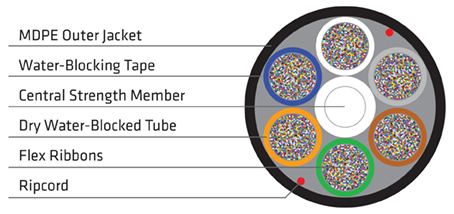Data centres around the globe are experiencing ever-growing demand for higher bandwidths, faster speeds, greater capacity, as the constant pressure on communication networks increase. Link speeds have exploded, moving from 10G to 40G, then rapidly progressing to 100G and now the advent of 400G. High-capacity workloads require high performing data centre infrastructure that can grow and evolve to changing needs.
With the explosive demand for data driving an expansion of data centers worldwide, data centres must adapt. As data centre models evolve to become more dynamic, agile and distributed, the enabling technologies for this digital transformation must be more reliable, energy-efficient and secure.
One emerging solution is dark fibre ribbon cabling, a high-density solution that is both scalable and cost effective to manage and maintain. Dark fibre ribbon cable, with capacity for high bandwidth, long transmission distance and flexibility, is now widely adopted as the standard for cabling in the data centre environment – an inevitability as data centres implement 400G as the next generation of cloud infrastructure.

Higher bandwidth and capacity demands push for higher fibre counts. In the past, data centres used no more than 96 strands. This included coverage for diverse and redundant routing. But today, fibre counts of 144, 288, and 864 are typical but high fibre count takes up crucial space in raceways. Large cable diameter brings performance challenges. Hence the move towards rollable-ribbon construction and 200-micron fibre.
The primary distinction between ribbon cables and conventional loose tube cables is the way the individual fibres are packaged and managed within the cable. Standard ribbon fibre bonds have 12 strands along the length of the cable. But rollable ribbon fibre is intermittently bonded. As a result, the fibre is rolled and does not lay flat. The rollable-ribbon design allows 3,456 strands to fit into a five-centimetre) duct, whereas the flat design can only allow half the strands to fit in the same space.
With this structure, ribbon fibre cables enable mass-fusion splicing, with 12 fibres spliced in a single procedure for easier fibre management, faster network builds and quicker restoration following fibre cable cuts – saving time and money but importantly, minimising risk. With conventional fibres you run the risk of impacting multiple customers if one cable is cut or damaged.
Unlike other cabling solutions that require all terminations to be made day one, dark fibre ribbon can be incrementally spliced. This splice as you go method provides great scalability and the termination costs are only incurred when the connection is required.
The advantages:
- Speed – perform simpler, faster mass fusion splicing so that all fibres in the ribbon matrix can be spliced together at the same time meaning less installation time, less labour cost and significantly less emergency restoration time.
- Space saving – smaller footprint in splice enclosures and telecommunications room fibre management; greater packing density in higher fibre counts enabling more efficient use of limited duct space
- Increase capacity – increase fibre density in every cable
- Reduce cost – very cost competitive in counts above 96 fibres
- Reduce downtime – rapid re-splicing minimises the loss between every splicing point
These advantages are the reason that dark fibre ribbon cabling is now becoming the industry standard for data centres and telecommunication networks across the country. With stringent Service Level Agreements and uptime requirements, such organisations must guarantee the performance of their networks with technology that delivers on the promise. And dark fibre ribbon solutions do just that.
And as technological innovation escalates in the years ahead, the pressure on hyperscale data centres will require data centre operators to take future-proofed cabling solutions to cope with the growing needs – or lose the competitive advantage.
Alliance SI has worked with large data centres and hyperscalers across Australia to upgrade cabling infrastructure and deliver improved performance and reliable speed. Interested to learn more, speak to a Data Centre Specialist today.

